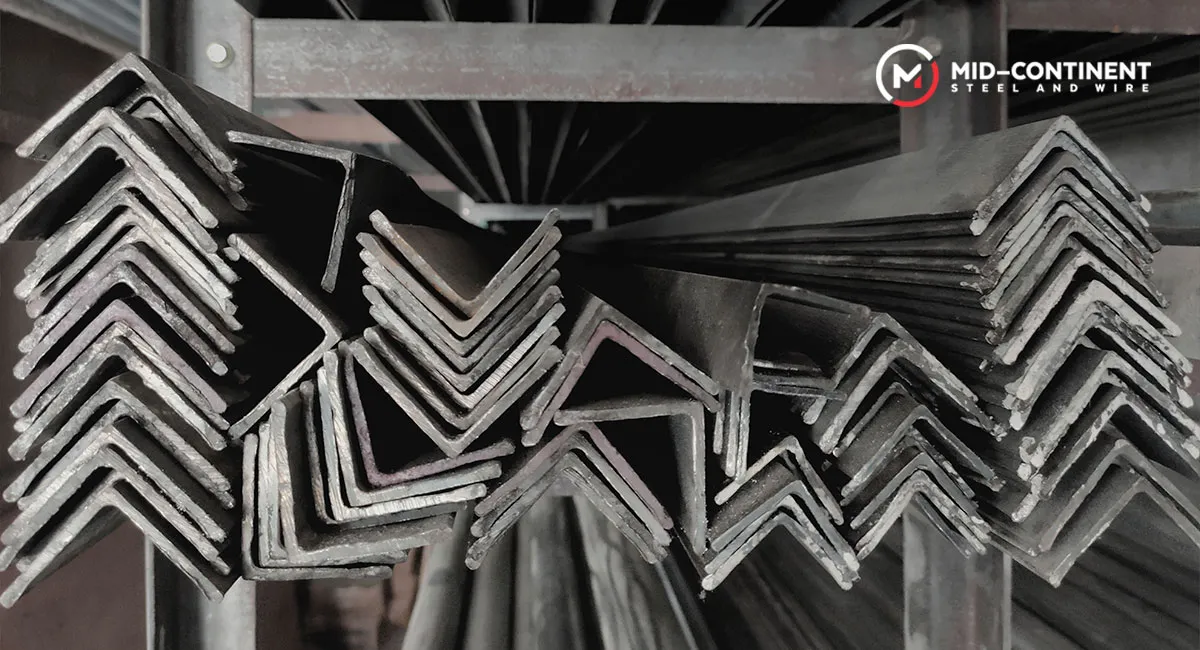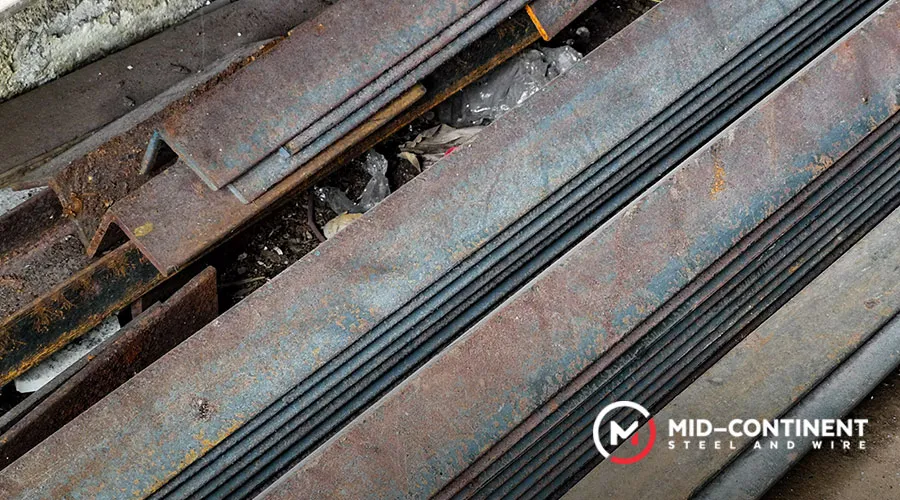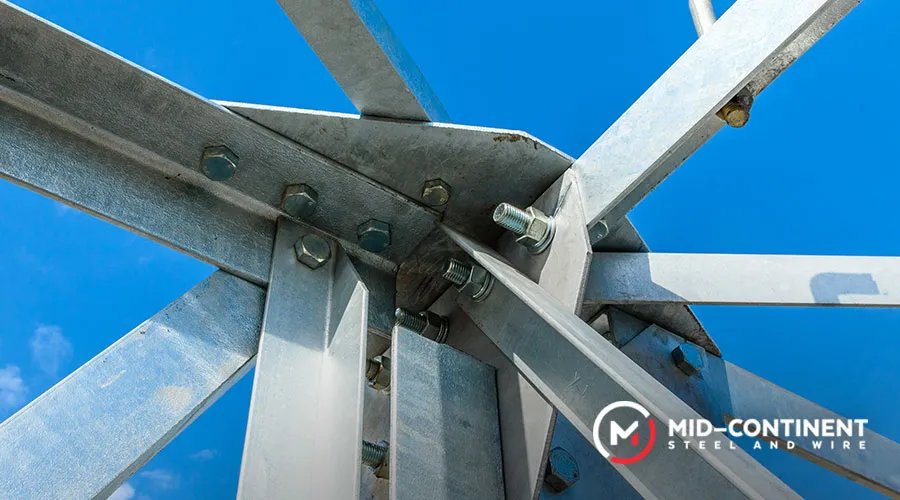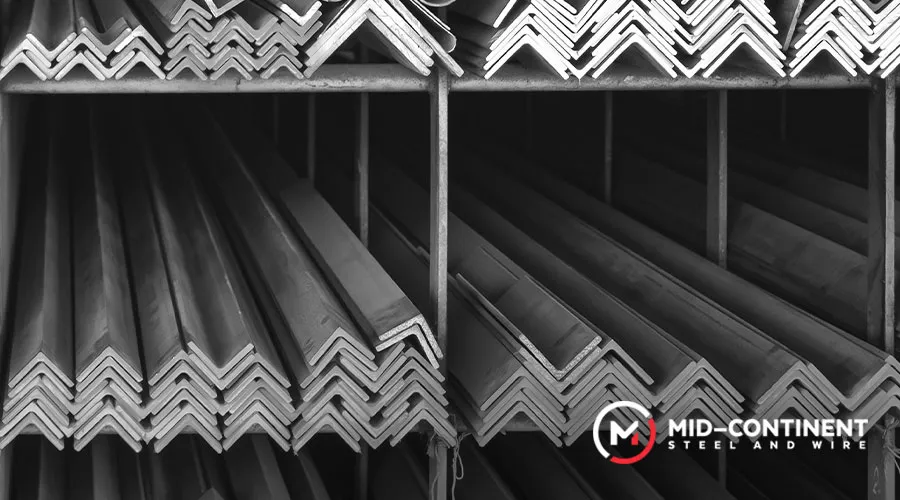
A steel angle is a structural steel product with an L-shaped cross-section. Its simple geometry provides exceptional strength and rigidity relative to its weight. This product is one of the most common types of shapes used in construction and manufacturing. The terms angle iron, shape angle, and steel angle are often used interchangeably to describe this essential component.
Its effectiveness depends on selecting the correct size, type, and material grade for the job. Let’s dive into more about this component.

Common steel angle sizes
Steel angles are categorized into two primary types based on the dimensions of their legs: equal leg and unequal leg. Understanding this distinction and the standard naming convention is very important for proper selection.
Equal leg angles: When angles have two legs of the same length. They are specified by the leg length and thickness. For example, a 3″ x 3″ x ¼” angle has two 3-inch legs and a thickness of one-quarter inch. This symmetrical shape provides uniform strength along both axes, making it ideal for general-purpose applications like bracing, frames, and supports where loads are distributed evenly.
Unequal leg angles: An unequal leg angle features legs of different lengths, providing a higher strength-to-weight ratio along one axis. They are specified by listing the longer leg first, followed by the shorter leg and then the thickness (e.g., 4″ x 3″ x ⅜”). This configuration is advantageous in applications where the primary bending force is applied in a specific direction.
In industry terminology, a distinction is often made between bar angle and structural angles. While not a formal ASTM classification, bar angle typically refers to smaller angles, often with leg sizes less than 3 inches. These are commonly used for light-duty framing, brackets, and repairs. Structural angles generally have leg dimensions of 3 inches or greater and are intended for more substantial load-bearing applications in buildings, bridges, and heavy equipment.

Factors to consider when choosing size
Choosing the right steel angle involves a careful evaluation of load requirements, environmental conditions, and material properties. This decision requires balancing performance with cost and long-term durability.
1. Load and stress requirements: This involves calculating the tensile strength and the yield point. These mechanical properties are determined by the steel grade.
2. Material grade: The chemical composition of the steel indicates its performance. Several standard specifications are common:
- A36 steel: The most common grade of carbon structural steel. An A36 steel angle offers a minimum yield point of 36,000 psi (36 ksi) and excellent weldability and machinability. Its balance of strength, formability, and cost makes it a reliable choice for most general-purpose structural needs.
- A588 steel: This high-strength, low-alloy steel forms a stable, rust-like effect when exposed to the elements, eliminating the need for painting and providing superior corrosion resistance. With a higher yield point (typically 50 ksi), A588 steel is used in exposed structures for strength and atmospheric corrosion protection.
- Stainless steel angle: For maximum corrosion resistance. Grades like 304 and 316 offer excellent protection against rust and chemical damage.
How to measure structural steel angles
Here’s a step-by-step guide on what you need to measure your angles.
1. Leg length (A and B): The leg lengths are measured from the outer corner (the “heel”) to the end of the leg (the “toe”). Use a tape measure or caliper and place the end firmly against the corner. For an equal leg angle, both measurements will be the same. For an unequal leg angle, measure each leg separately.
2. Thickness (T): The thickness is the measurement of the material’s cross-section. It should be measured away from the corner. Use calipers for the most accurate reading, placing them on the flat part of the leg.

Applications of different sizes
The versatility of steel angles means they are found in nearly every sector of industry and construction. The size of the angle directly corresponds to its typical application, ranging from lightweight framing to heavy-duty structural support.
Small steel angles (Legs < 3 inches): Often classified as bar angle, these smaller sizes are perfect for applications where high load capacity is not the primary concern.
- Framing
- Brackets and cleats
- Reinforcement
Medium to large steel angles (Legs ≥ 3 inches): These are designed for significant load-bearing roles. They are distinct from solid steel bars, offering superior bending resistance for their weight.
- Building construction
- Transmission lines
- Heavy equipment
Mid-Continent Steel and Wire angle bars
Mastering the nuances of steel angle sizes is fundamental to successful engineering and fabrication. By understanding the critical differences, you can specify components with precision and confidence.
When it comes to structural integrity, performance, and reliability, Mid Continent Steel and Wire stands out as a trusted leader in the steel manufacturing industry. Our steel angles are not only engineered for strength but also produced with a level of quality and consistency that exceeds industry standards.
- Standard lengths: 20ft-60ft (Shorter Cut Lengths also available)
- Steel grades: ASTM A36, A529-50, A529-55, A992 & A572-50
- Charpy test: Available upon request
- Uses and applications: Braces for structural components like bridges or buildings, framing, brackets, and many other uses.
We have the materials that will elevate your project.